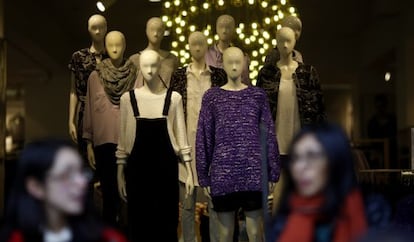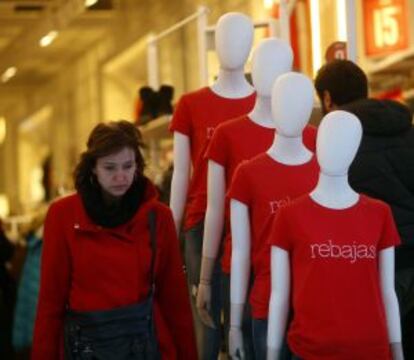Attack of the fashion clones
Spain is a world leader in prêt-à-porter clothing, so why do so many Spaniards dress alike?


Consider the following: Maite Bravo and Mar Bonilla, two friends who work for the same communication company in Madrid, step into the elevator at work one day and stare at each other in disbelief. They are wearing exactly the same outfit: same black pants, same cream-colored blouse with black cuffs, and even the same high-heeled boots.
And because both of them are in their forties, have similar builds and nearly identical haircuts, each one is now facing the prospect of spending 10 hours sitting next to a clone of herself.
Their place of work does not have a dress code but it might as well, considering its employees’ attire. There is no one dominating style – instead, there are are several identifiable patterns depending on whether the wearer is a computer technician, a boss or an intern. But the patterns are clearly there, as they are on the streets.
Two out of every three euros spent on clothes went to no more than a dozen brands
The Mar and Maite incident was not the result of an unpropitious star alignment. It was a matter of statistics. Both women buy their clothes in the same stores, and occasionally they even shop together at a mall near their workplace during their lunch break.
This shopping center, like so many others in Spain, houses a number of Inditex-owned stores – including a Zara, Massimo Dutti, Bershka and Pull & Bear – as well as those belonging to other well-known fashion names such as Mango, H&M and Cortefiel.
Statistics show that Spaniards spent 31 percent of their clothing budget at large fashion retail stores in 2013. Another 24 percent of their money was spent in hypermarkets such as Carrefour or Alcampo, which carry all kinds of consumer goods. Podemos leader Pablo Iglesias has confessed he buys his shirts at Alcampo. Another 10 percent was spent in Spain’s flagship department store chain, El Corte Inglés.
In other words, two out of every three euros spent on clothes went to no more than a dozen brands, according to Acotex, the Spanish Association of Textile Commerce and Accessories. The other third of the budget gets shared out between multi-brand stores (20 percent) and outlets (15 percent).

This highly concentrated demand (and supply) goes a long way toward explaining why Spanish society seems to dress so uniformly.
Leaving aside life’s big events, such as weddings and baptisms, most Spaniards keep to a range of styles that depend on age, social status and personal taste. There may be eight or 10 archetypal looks that most people conform to.
But the fact that most of the country renews its wardrobes at the same stores – and it is known that even Spain’s Queen Letizia buys her everyday clothes at Mango – does not fully explain such a tremendous coincidence. After all, those retail stores offer tens of thousands of different options every season, and rotate their stock every week.
“It’s true that Spanish society is more conservative than others in terms of the way people dress. But ultimately, each person has a particular taste and three or four styles that he or she feels comfortable with. We each seek those styles in different places depending on our purchasing power: either at street markets or at luxury stores. What we do is try to make them all available at our stores,” says a spokesperson for Inditex.
The fashion world works in a well-known way. Months before each season begins, international shows create global trends, dictating the patterns, fabrics and colors that will later be worn all over the world. When the season begins, prêt-à-porter stores – particularly Spanish ones, which are world leaders – convert those high-caliber proposals into affordable items and then submit them to their customers for approval. The items that sell well get made again. Those that don’t get pulled or quickly repurposed. In the end, it is hard to ascertain whether stores offer what customers want or whether customers demand what stores have to offer. In any case, the system is highly efficient at shifting its wares.
We’re just like sheep. We love to imitate the boss or the leader, no matter whether the leader happens to be a rapper or a statesman”
Pilar Pasamontes, European Design Institute
“We’re just like sheep,” says Pilar Pasamontes, fashion director at the European Design Institute and vice-president of Modafad, a designer association from Barcelona. “We love to imitate the boss or the leader, no matter whether the leader happens to be a rapper or a statesman.
“A majority of people feel good within a social comfort zone that is created by dressing according to their lifestyle, or the lifestyle they would like to have. And so we have the pijos [the rich kids], the chonis [working-class girls], the women who favor the multicolored clothes from Desigual, the ladies with the highlights in their hair, and the teens in running shoes.
“If you add the fact that you never see more than three or four haircuts, the result is a uniform society. Some people seek individuality, but they represent one percent compared to the masses. Given this scenario, there is a real danger that creators will indulge in self-censorship and produce only the things they know are going to sell well. And that is detrimental to everyone,” she adds.

The crisis has done its part to increase this homogeneous look. First, people do not refresh their wardrobes as much. In 2007, each household spent an average €1,853 on clothes. In 2013, that figure had dropped to €1,109, according to Acotex.
And there is a second reason, says sociologist Pedro Mansilla: “In times of need, you turn to the essentials, to the long-lasting clothes, to the dark colors, to gray, to black, as though you were making a statement about personal dignity amid so much chaos. That, coupled with the fact that half the population wears jeans, leads to a monochrome landscape.”
Now that Madrid Fashion Week is upon us, it is to be expected that some of the creations thought up by our designers will soon come down to street level. Just in case, Mar and Maite have decide to send each other a WhatsApp message every day with information about their dressing choices, in order to avoid another “day of the clones” at work.
Tu suscripción se está usando en otro dispositivo
¿Quieres añadir otro usuario a tu suscripción?
Si continúas leyendo en este dispositivo, no se podrá leer en el otro.
FlechaTu suscripción se está usando en otro dispositivo y solo puedes acceder a EL PAÍS desde un dispositivo a la vez.
Si quieres compartir tu cuenta, cambia tu suscripción a la modalidad Premium, así podrás añadir otro usuario. Cada uno accederá con su propia cuenta de email, lo que os permitirá personalizar vuestra experiencia en EL PAÍS.
¿Tienes una suscripción de empresa? Accede aquí para contratar más cuentas.
En el caso de no saber quién está usando tu cuenta, te recomendamos cambiar tu contraseña aquí.
Si decides continuar compartiendo tu cuenta, este mensaje se mostrará en tu dispositivo y en el de la otra persona que está usando tu cuenta de forma indefinida, afectando a tu experiencia de lectura. Puedes consultar aquí los términos y condiciones de la suscripción digital.
Últimas noticias
The complicated life of Francesca Albanese: A rising figure in Italy but barred from every bank by Trump’s sanctions
How Japan is trying to avert ‘digital defeat’
Half of Scotland is in the hands of 420 property owners
Reinhard Genzel, Nobel laureate in physics: ‘One-minute videos will never give you the truth’
Most viewed
- Pablo Escobar’s hippos: A serious environmental problem, 40 years on
- Why we lost the habit of sleeping in two segments and how that changed our sense of time
- Charles Dubouloz, mountaineering star, retires at 36 with a farewell tour inspired by Walter Bonatti
- Reinhard Genzel, Nobel laureate in physics: ‘One-minute videos will never give you the truth’
- The Florida Keys tourist paradise is besieged by immigration agents: ‘We’ve never seen anything like this’








































